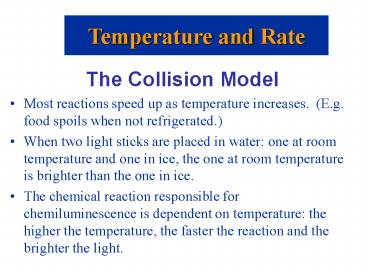The Collision Model PowerPoint PPT Presentation
Title: The Collision Model
1
Temperature and Rate
- The Collision Model
- Most reactions speed up as temperature increases.
(E.g. food spoils when not refrigerated.) - When two light sticks are placed in water one at
room temperature and one in ice, the one at room
temperature is brighter than the one in ice. - The chemical reaction responsible for
chemiluminescence is dependent on temperature
the higher the temperature, the faster the
reaction and the brighter the light.
2
Temperature and Rate
As Temperature Increases, the Rate Increases.
Collision Model
3
Temperature and Rate
- The Collision Model
- Since the rate law has no temperature term in it,
the rate constant must depend on temperature. - Consider the first order reaction CH3NC ? CH3CN.
- As temperature increases from 190 ?C to 250 ?C
the rate constant increases from 2.52 ? 10-5 s-1
to 3.16 ? 10-3 s-1. - The temperature effect is quite dramatic. Why?
- Observations rates of reactions are affected by
concentration and temperature.
4
Temperature and Rate
- The Collision Model
- Goal develop a model that explains why rates of
reactions increase as concentration and
temperature increases. - The collision model in order for molecules to
react they must collide. - The greater the number of collisions the faster
the rate. - The more molecules present, the greater the
probability of collision and the faster the rate.
5
Temperature and Rate
- The Collision Model
- The higher the temperature, the more energy
available to the molecules and the faster the
rate. - Complication not all collisions lead to
products. In fact, only a small fraction of
collisions lead to product. - The Orientation Factor
- In order for reaction to occur the reactant
molecules must collide in the correct orientation
and with enough energy to form products.
6
Temperature and Rate
The Orientation Factor Consider Cl NOCl ? NO
Cl2 There are two possible ways that Cl
atoms and NOCl molecules can collide one is
effective and one is not.
7
Temperature and Rate
The Orientation Factor
8
Temperature and Rate
- Activation Energy
- Arrhenius molecules must posses a minimum amount
of energy to react. Why? - In order to form products, bonds must be broken
in the reactants. - Bond breakage requires energy.
- Activation energy, Ea, is the minimum energy
required to initiate a chemical reaction.
9
Temperature and Rate
- Activation Energy
- Consider the rearrangement of methyl isonitrile
- In H3C-N?C, the C-N?C bond bends until the C-N
bond breaks and the N?C portion is perpendicular
to the H3C portion. This structure is called the
activated complex or transition state. - The energy required for the above twist and break
is the activation energy, Ea. - Once the C-N bond is broken, the N?C portion can
continue to rotate forming a C-C?N bond.
10
(No Transcript)
11
Temperature and Rate
- Activation Energy
- The change in energy for the reaction is the
difference in energy between CH3NC and CH3CN. - The activation energy is the difference in energy
between reactants, CH3NC and transition state. - The rate depends on Ea.
- Notice that if a forward reaction is exothermic
(CH3NC ? CH3CN), then the reverse reaction is
endothermic (CH3CN ? CH3NC).
12
Temperature and Rate
- Activation Energy
- How does a methyl isonitrile molecule gain enough
energy to overcome the activation energy barrier? - From kinetic molecular theory, we know that as
temperature increases, the total kinetic energy
increases. - We can show the fraction of molecules, f, with
energy equal to or greater than Ea is - where R is the gas constant (8.314 J/molK).
13
Temperature and Rate
Activation Energy
14
Temperature and Rate
- The Arrhenius Equation
- Arrhenius discovered most reaction-rate data
obeyed the Arrhenius equation - k is the rate constant, Ea is the activation
energy, R is the gas constant (8.314 J/K-mol) and
T is the temperature in K. - A is called the frequency factor.
- A is a measure of the probability of a favorable
collision. - Both A and Ea are specific to a given reaction.
15
Temperature and Rate
- Determining the Activation Energy
- If we have a lot of data, we can determine Ea and
A graphically by rearranging the Arrhenius
equation - From the above equation, a plot of ln k versus
1/T will have slope of Ea/R and intercept of ln
A.
16
Temperature and Rate
17
Temperature and Rate
- Determining the Activation Energy
- If we do not have a lot of data, then we
recognize

